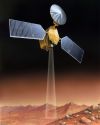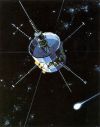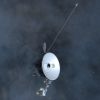Emily Lakdawalla • Oct 29, 2009
What's up in the solar system in November 2009
There are two -- actually three -- big things to look forward to this month. We have a double event to look forward to on Cassini: a pair of ultra-close Enceladus flybys spaced only 19 days apart, on November 2 and 21. And ESA's Rosetta will be returning to Earth for a final hello and goodbye; its third and last Earth flyby is on November 13. More details on those events follow. But let's take an orderly path through the solar system.
In the inner solar system:
 The MESSENGER team has announced they'll have a press briefing about the third flyby, with new image releases, on Tuesday, November 2; I'll be listening in. In the meantime, they're posting regular image updates, though at a decreasing frequency. They have to pace themselves; nothing of much more significance will happen on the mission until Mercury orbit insertion on March 18, 2011, though I expect to see some interesting science publications between now and then, based upon what they learned during the three flybys.
The MESSENGER team has announced they'll have a press briefing about the third flyby, with new image releases, on Tuesday, November 2; I'll be listening in. In the meantime, they're posting regular image updates, though at a decreasing frequency. They have to pace themselves; nothing of much more significance will happen on the mission until Mercury orbit insertion on March 18, 2011, though I expect to see some interesting science publications between now and then, based upon what they learned during the three flybys.
 As expected, ESA's Venus Express mission to Venus has been extended until the end of 2012. If it remains healthy, it should therefore still be operating when JAXA's Akatsuki, planned for launch next summer, arrives at the end of 2010 or beginning of 2011.
As expected, ESA's Venus Express mission to Venus has been extended until the end of 2012. If it remains healthy, it should therefore still be operating when JAXA's Akatsuki, planned for launch next summer, arrives at the end of 2010 or beginning of 2011.
 Lunar Reconnaissance Orbiter is busily mapping the Moon from its science orbit. The latest featured image releases have been spectacular. This page is better for browsing the images but doesn't get you to the "featured image" captions. I love the gully features in the rim of crater Epigenes A.
Lunar Reconnaissance Orbiter is busily mapping the Moon from its science orbit. The latest featured image releases have been spectacular. This page is better for browsing the images but doesn't get you to the "featured image" captions. I love the gully features in the rim of crater Epigenes A.
At the Sun:
 The ESA/NASA SOHO mission has been watching sunspot 1029 balloon into action, providing a fun target for solar astronomers. As always, SOHO's near-real-time data and images are available here.
The ESA/NASA SOHO mission has been watching sunspot 1029 balloon into action, providing a fun target for solar astronomers. As always, SOHO's near-real-time data and images are available here.
 The twin STEREO spacecraft are currently 62 degrees ahead (STEREO A) and 61 degrees behind (STEREO B) Earth; STEREO A has a lovely view of sunspot 1029. They're far enough apart now that the mission homepage now features a neat rotating view of the two spacecraft's images that covers nearly the entire Sun. The daily STEREO image viewer includes the latest SOHO image, which gives you three slightly different viewpoints on the current appearance of the Sun.
The twin STEREO spacecraft are currently 62 degrees ahead (STEREO A) and 61 degrees behind (STEREO B) Earth; STEREO A has a lovely view of sunspot 1029. They're far enough apart now that the mission homepage now features a neat rotating view of the two spacecraft's images that covers nearly the entire Sun. The daily STEREO image viewer includes the latest SOHO image, which gives you three slightly different viewpoints on the current appearance of the Sun.
On to Mars:
Out at Mars, Tuesday was the southern hemisphere's autumnal equinox, so we're now in early southern hemisphere autumn (Ls 2°). The Mars Exploration Rovers' sunlit days are now shorter than their nights, and getting shorter every sol. This is much more important for Spirit than it is for Opportunity, because the former is farther south. Opportunity is still racking up the meters, achieving good distances of 30 to 70 meters on each driving day. As for Spirit, it is still stuck, but the process of extricating it is grinding slooooowly forward; there was a formal review of the extrication plan on the 28th, and word should come soon on whether the plan is approved. If it is, they'll probably begin the process on November 9. Here's A. J. S. Rayl's latest update on what the rovers have been doing for the past month.
 Mars Reconnaissance Orbiter is still in safe mode; more on that here. Remember how I said Mars just passed through its equinox? That means Mars Reconnaissance Orbiter has missed its chance to watch the Sun arrive to Mars' frozen north this Martian year. Almost 2 more Earth years will pass before it has its next chance. Will the orbiter still be doing science then?
Mars Reconnaissance Orbiter is still in safe mode; more on that here. Remember how I said Mars just passed through its equinox? That means Mars Reconnaissance Orbiter has missed its chance to watch the Sun arrive to Mars' frozen north this Martian year. Almost 2 more Earth years will pass before it has its next chance. Will the orbiter still be doing science then?
 ESA's Mars Express is still diligently mapping Mars, and also had its mission extended to 2012 like its sister Venus Express. The Mars Webcam is currently returning high-phase shots of Mars, including some with some high clouds visible on the terminator and over the north pole.
ESA's Mars Express is still diligently mapping Mars, and also had its mission extended to 2012 like its sister Venus Express. The Mars Webcam is currently returning high-phase shots of Mars, including some with some high clouds visible on the terminator and over the north pole.
 NASA's Mars Odyssey remains the longest-lived spacecraft in orbit at Mars. You can see the latest from its THEMIS instrument here. Lately the theme to their images has been dunes, dunes, and more dunes, making gorgeous repeating patterns on the Martian surface.
NASA's Mars Odyssey remains the longest-lived spacecraft in orbit at Mars. You can see the latest from its THEMIS instrument here. Lately the theme to their images has been dunes, dunes, and more dunes, making gorgeous repeating patterns on the Martian surface.
Exploring Saturn:
Cassini is entering what is probably the most challenging month of its Equinox Mission, containing not one but two close flybys of Enceladus. The first on November 2, will be within 102.7 kilometers of the surface at 89°S latitude, giving Cassini its deepest passage yet through the plumes. Because Cassini is now orbiting in the plane of the rings, and in the same direction as the moons orbit, this encounter will be at a much slower relative speed than the earlier close flybys that approached from over the north pole. Apparently the slower encounter will be etremely beneficial for in situ measurements. Then, on the 21st, Cassini will fly past at a greater (but still small) distance of 1,606 kilometers, with the closest approach over 82°S latitude, directly after which it will have an excellent point of view on Rhea, only 25,000 kilometers away at closest approach. These encounters occur on consecutive orbits, Revs 120 (the current orbit) and 121 of its tour. The orbit period is currently 19 days, with a low, half-degree inclination and a periapsis at relatively high phase of 110°. That high-phase point of view has made for pretty pictures of Saturn lately.
Quietly cruising:
Rosetta is approaching fast for its November 13 Earth flyby. Observations of the Earth-Moon system start November 6 and continue through November 19. Closest approach will be at 07:45:40.1 November 13 UTC an altitude of 2,481 kilometers over 109°E, 8°S -- just off the coast of the Indonesian island of Java. The next big science event for Rosetta will be the flyby of asteroid Lutetia in July of 2010.
 The International Cometary Explorer remains on course for a return visit to Earth in 2014. When it does, ICE can be returned to a Sun-Earth L1 halo orbit, or can use multiple Earth swingbys to encounter Comet Wirtanen during its near-Earth apparition in December 2018.
The International Cometary Explorer remains on course for a return visit to Earth in 2014. When it does, ICE can be returned to a Sun-Earth L1 halo orbit, or can use multiple Earth swingbys to encounter Comet Wirtanen during its near-Earth apparition in December 2018.
![]() In the asteroid belt, NASA's Dawn has resumed steady thrusting of its ion engines, patiently propelling itself toward a rendezvous with Vesta in July 2011.
In the asteroid belt, NASA's Dawn has resumed steady thrusting of its ion engines, patiently propelling itself toward a rendezvous with Vesta in July 2011.
 NASA's Deep Impact is cruising toward its 2010 flyby of comet 103P/Hartley 2.
NASA's Deep Impact is cruising toward its 2010 flyby of comet 103P/Hartley 2.
 NASA's Stardust is cruising ever onward toward a Feburary 14, 2011 encounter with comet Tempel 1. The October status reports indicate the spacecraft is in good health.
NASA's Stardust is cruising ever onward toward a Feburary 14, 2011 encounter with comet Tempel 1. The October status reports indicate the spacecraft is in good health.
 As of October 29 JAXA's Hayabusa is fine. It's still on track to return to Earth in June 2010.
As of October 29 JAXA's Hayabusa is fine. It's still on track to return to Earth in June 2010.
 NASA's New Horizons has 16.93 AU to go to reach Pluto. It's still on course for a January to July 2015 encounter with the Pluto and Charon system.
NASA's New Horizons has 16.93 AU to go to reach Pluto. It's still on course for a January to July 2015 encounter with the Pluto and Charon system.
And beyond:
Finally, NASA's Voyager 1 and 2 spacecraft were still responding to commands from Earth as of September 25. Both have now crossed the "termination shock," where the solar wind slows down as it impinges upon the interstellar medium.
Some other milestones to take note of this month, taken mostly from JPL's Space Calendar:
- November 1 marks the end of Daylight Saving time in the U.S. but not Europe.
- November 9 would have been Carl Sagan's 75th birthday. We'll have a special Planetary Radio podcast with Ann Druyan.
- November 14 will be the 40th anniversary of the launch of the Apollo 12 mission.
- The space shuttle Atlantis is scheduled to launch for the Space Station on November 16
- November 16-19 there will be a meeting of the Lunar Exploration Analysis group; the second day, November 17, will feature results from LRO and LCROSS, which could include the first information on what the LCROSS team saw in their spectral data.
The Time is Now.
As a Planetary Defender, you’re part of our mission to decrease the risk of Earth being hit by an asteroid or comet.
Donate Today

 Explore Worlds
Explore Worlds Find Life
Find Life Defend Earth
Defend Earth

